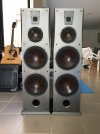Of course - my original posts said I love the Klippel data Erin provides
Great for our community
His subjective impressions, I don't believe he can hear a 2kHz scoop listening to music in a normal room, with room acoustics issues - all before seeing the simulated anechoic data
Matters of truthfulness aside, remember a wide, shallow deviation from flat as in the LS50 Meta is generally easier to hear than deeper, narrower one. This is shared often, so you may have seen it, but the following bumps are equally detectable in listening tests. (From Toole's book)
Note that it's actually easier to detect these at higher frequencies, presumably up to a point.
(Edited to include a more illustrative image)
Last edited:


